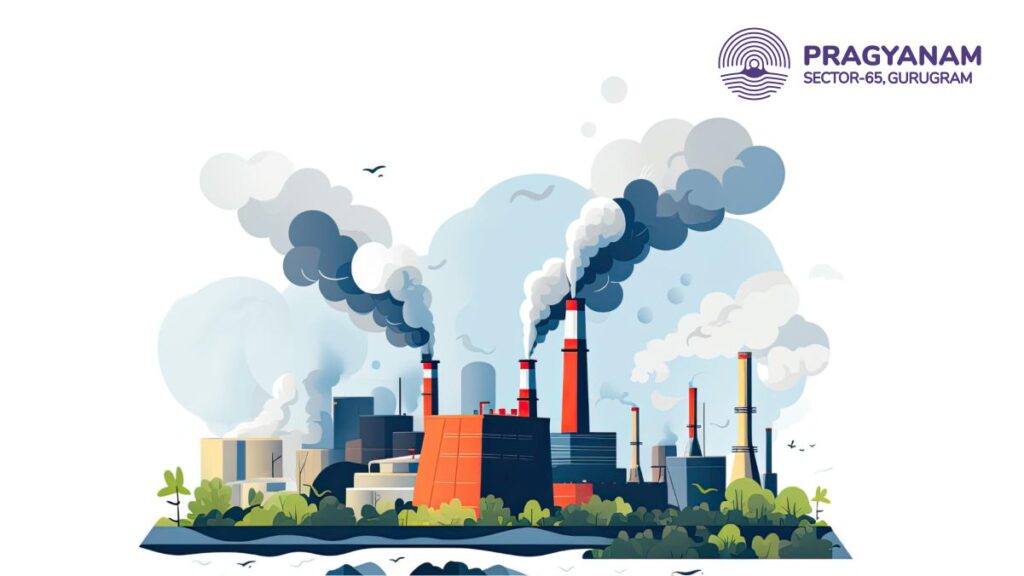Pollution is a major environmental issue that affects every aspect of life on Earth. It results from human activities, some natural processes, and industrial activities, and it affects water, land, air, and sound. Pollution has become a serious threat to the health of all living organisms, including humans, as well as the ecosystems that sustain life.
In this article, we’ll explore the types of pollution, their causes, their effects on the environment, and some possible solutions to mitigate their effects.
Table of Contents
1. Air Pollution
Air pollution occurs when harmful substances such as gases, particulate matter, and other inhalable substances are mixed with air. The sources of these pollutants can be both natural and man-made. Some common air pollutants are sulfur dioxide (SO2), Carbon Monoxide (CO), and other particulate matter like dust and fine debris. Air pollution is a major source of environmental pollution.
Some common causes of air pollution are:
a). Usage of fossil fuels: All industrial growth depends upon fossil fuels’ use. Whether driving to the office or operating machinery to produce goods, everything requires fossil fuels. Burning them causes emissions that harm the atmosphere and, in turn, harm our health.
b). Industrial emissions: All our industries require energy to produce the required goods and constantly emit harmful pollutants.
c). Agricultural Activities: Modern farming uses fertilizers and pesticides sprayed on crops. Some of these get mixed with the air, polluting it.
d). Natural sources: Sandstorms, wildfires, and volcanic eruptions also lead to considerable air pollution.
Effects of Air Pollution
a). Health problems: Constantly inhaling polluted air can lead to several respiratory diseases, such as Asthma, bronchitis, and heart ailments.
b). Reduced visibility: Every year, we notice farmers burn the rubble, and the smoke is carried by air to different areas, reducing the visibility of the surrounding areas.
c). Global warming: Polluted air acts as an insulated blanket, heating the air below. This leads to a rise in temperature and the melting of glaciers. Ocean water levels rise because of this, which causes floods in some areas as well.
d). Acid Rain: If rain pours over highly polluted air, Sulphur dioxide and Nitrogen oxide react with it and can cause acid rain. This is harmful to crops, buildings, and humans as well.

Solutions to Air pollution
a). Lower energy dependency: We can start using public transport and save electricity wherever we can to reduce emissions.
b). Emission regulation: The Government can impose strict regulations on industries and vehicles. Research and development grants can also be made to invest in alternative sources of clean energy.
c). Renewable energy: Solar, wind, and hydroelectric power should be promoted to reduce dependency on fossil fuels.
2. Water Pollution
Just like air, water is a resource required daily for many activities, be they natural or industrial. If harmful pollutants like chemicals, fertilizers, etc., are mixed with water, they can seep into the water supplies, making them unfit. This affects all aquatic life and human health.
Some common causes of water pollution are:
a). Sewage and wastewater: If household sewage and wastewater are not treated and disposed of correctly, they tend to pollute our water sources.
b). Agricultural waste: Nutrient pollution and eutrophication are caused when pesticides, fertilizers, and animal waste are mixed with water supplies due to inadequate disposal techniques.
c). Industrial Waste is the biggest source of water pollution. Factories work around the clock and emit harmful and untreated substances that contaminate our water supplies.
d). Oil Spills: Fuels are transported by ships, and sometimes, due to accidents, the fuels can be spilled and mixed with water bodies.
Effects of Water Pollution
a). Human Health: Polluted water is a source of waterborne diseases such as cholera, dysentery, and typhoid, which are linked to poor sanitation and contaminated water.
b). Aquatic Life: Toxic chemicals deplete oxygen in water bodies essential for aquatic life survival.
c). Damage to biodiversity: Water pollution damages the ecosystem by losing species and degradation of natural habitats.
d). Eutrophication: Excess chemicals from agricultural activities lead to unwanted algal blooms that deplete water oxygen, affecting marine life.

Solutions to Water pollution
a). Wastewater recycling: We can treat sewage and industrial wastewater to reduce water pollution.
b). Sustainable Farming Practices: To control water pollution, we can promote organic methods that use fewer chemicals and fertilizers.
c). Oil spill control: We can implement advanced techniques and strict regulations for efficient oil extraction and transport, leading to fewer oil spills.
3. Land Pollution
It results from the degradation of the earth’s surface by accumulating untreated waste and harmful substances that harm human health and biodiversity.
Causes of Land Pollution –
a). Agricultural wastes: Pesticides and fertilizers are used in agriculture, and they contaminate the soil, reduce its fertility, and harm the local wildlife.
b). Deforestation: Cutting trees for agriculture, urbanization, and other industrial activities leads to soil erosion and the loss of natural habitats.
c). Waste Disposal: Land pollution is also caused by improper household, industrial, and commercial waste disposal. Accumulating waste in landfills, especially non-biodegradable materials like plastic, creates long-term environmental pollution.
d). Mining: When we extract fuels and minerals from the earth for human use, a lot of toxic waste is left behind, which pollutes the land.
Effects of Land Pollution
a). Contaminated food chain: degraded soil can introduce harmful substances that can contaminate our food supplies.
b). Loss of Habitat: deforestation and contaminated land lead to habitat destruction, affecting wildlife population and biodiversity.
c). Health Risks: The contaminated soil is also a source of various human diseases and ailments.
d). Soil Degradation: The wastes mixed with soil lead to reduced agricultural productivity.

Solutions to Land Pollution
a). Land restoration: Reforestation and soil conservation practices must be implemented.
b). Waste recycling and management: Implementing efficient production techniques to reduce waste generation and recycling programs for the generated waste.
c). Sustainable agriculture: Lesser use of pesticides and chemicals and promotion of organic farming methods should be promoted.
d). Government regulations: All mining, deforestation, and industrial processes should be monitored to minimize land pollution.
4. Noise Pollution
Noise pollution results from harmful and excessive levels of sound that disrupt normal activities harm human health and affect wildlife.
Industrial activities, urban environments, construction, and transportation are major sources of noise pollution.
Causes of Noise Pollution –
Industrial Operations: Factories, mills, and power plants generate significant noise.
Construction activities: Heavy machinery and tools are used in construction, which creates loud sounds that disturb the environment.
Traffic: All our transportation media contribute significantly to sound pollution.
Urban activities: Weddings, concerts, and other entertainment activities are also major contributors to sound pollution.
Effects of Noise Pollution
Mental health issues: Long-term exposure to loud noises increases anxiety, depression, and stress levels.
Hearing impairment: Chronic exposure to high noise levels can also lead to auditory ailments and hearing loss.
Improper sleep: Proper sleep cannot be attained in high-noise environments, which leads to various health issues and constant fatigue.
Wildlife Disruption: Noise pollution disturbs animal breeding, migration, and animal communication.

Solutions to Noise pollution
Noise level regulation – Self-imposed and Government-imposed noise level regulations should be implemented.
Soundproofing – Installation of soundproof material in buildings and factories can significantly affect the level of sound pollution.
Urban Planning – Creating designated quiet zones and noise barriers is also a possible solution to this.
These four types of pollution are in tandem affecting our environment.
We need to combat these issues by adapting to sustainable practices, enforcing regulations, self-control, and raising awareness about our planet. We can protect our earth by making informed decisions and thus reducing all types of pollution.
Pragyanam School, one of the best CBSE schools in Gurgaon, teaches students about the importance of the environment in our lives, the harmful effects of pollution, and the ways to combat it. The school integrates hands-on gardening activities and environmental science lessons highlighting sustainable practices and encouraging eco-friendly habits.





